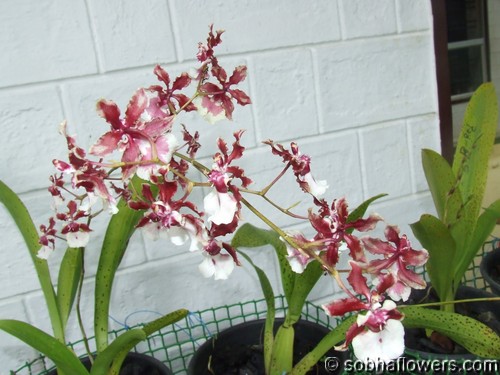Temperature
Tempaeratures for this group are
generally considered intermediate to warm:
55 to 60 F at night, and 80 to 85 F during
the day. Temperatures up to 95 to 100F are
tolerated if humidity and air movement are
increased as the temperatures rise, a good
general rule in any case.


|
|
Light
Light needs can vary from
bright to nearly full
direct sun depending on the species.
Most will thrive with one to several hours
of sun a day. Generally, thickerleaved plants,
such as “mule-ear” and “
equitant” oncidiums, can stand more light. In
a greenhouse, 20 to 60 percent shade is required,
or about 2,000 to 6,000 footcandles, depending
on the plants. In the home,
east, south or west windows are ideal. Many
types of oncidiums will grow under artificial
light: Four fluorescent tubes supplemented with
incandescent bulbs and placed 6 to 12 inches over
the plants are necessary
for proper growth. Metal-halide and sodium-vapor
bulbs also provide sufficient
light without needing to be so close
to the plants. |
Humidity
Humidity should be between 30
and 60 percent. Many
oncidiums require less humidity than other orchids.
Most greenhouses
have adequate humidity. In the
home, placing the plants above moist pebbles
in trays is ideal.
Fertilize
Fertilize regularly while plants
are
actively growing. Applications of 30-10-10formulations
twice a month are ideal for plants in a bark-based
potting medium A
20-20-20 formulation should be used on
plants in other media or on slabs. If skies
are cloudy, applications once a month are
sufficient.
 |
|
Potting
Potting should be done when new
growth is about one-half mature, which is usually in the spring. Fine-grade potting media are usually used with fine-rooted
plants and coarser mixes with large-rooted plants; the standard size is medium
grade. The plant should be positioned in the pot so that the newest growth
is farthest away from the edge of the pot, allowing the maximum number of new
growths before crowding the pot. Spread the roots over a cone of potting medium
and fill in around the roots. Firm the medium around the roots. Keep humidity
high and the potting medium dry until new roots form. |
 |
|
Water
Water requirements vary with
the type of
plant. Generally, plants with large fleshy roots
or leaves need less-frequent watering than thin-leaved
or thin-rooted plants. Watering
should be thorough, and the medium should
dry at least halfway through the pot
before watering again. This may be every
two to 10 days depending on weather, pot
size and material, type of orchid and type
of potting medium. Plants not actively growing
should be watered less; many species have winter
rest periods. |
|
